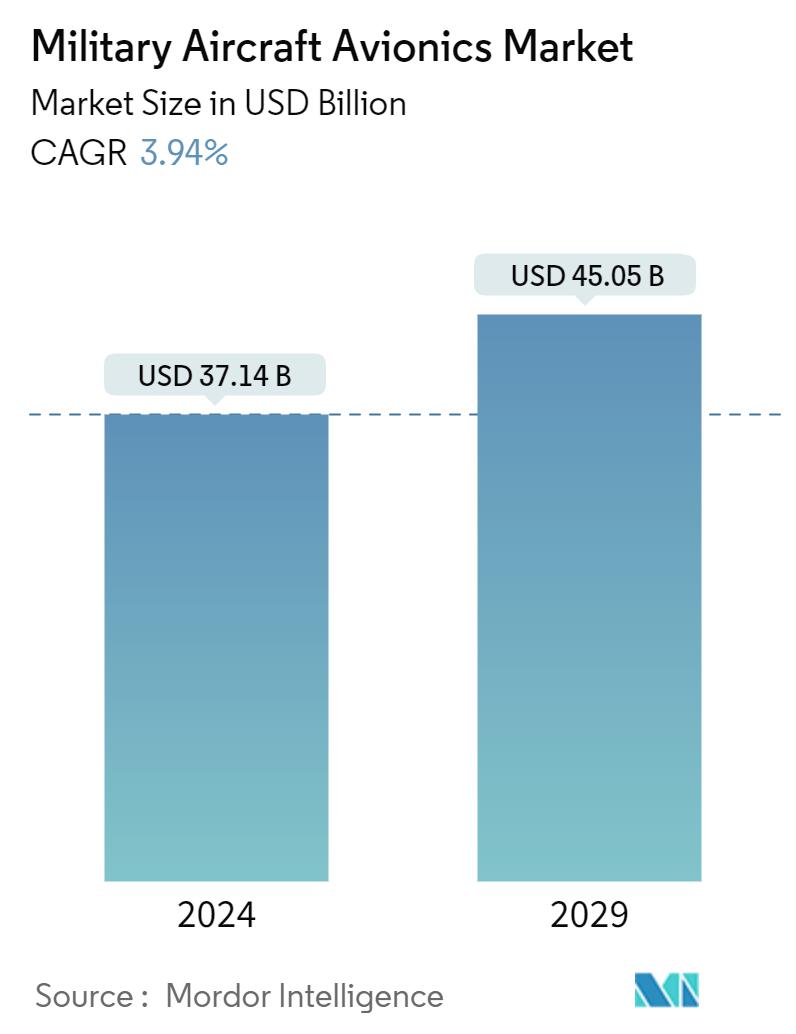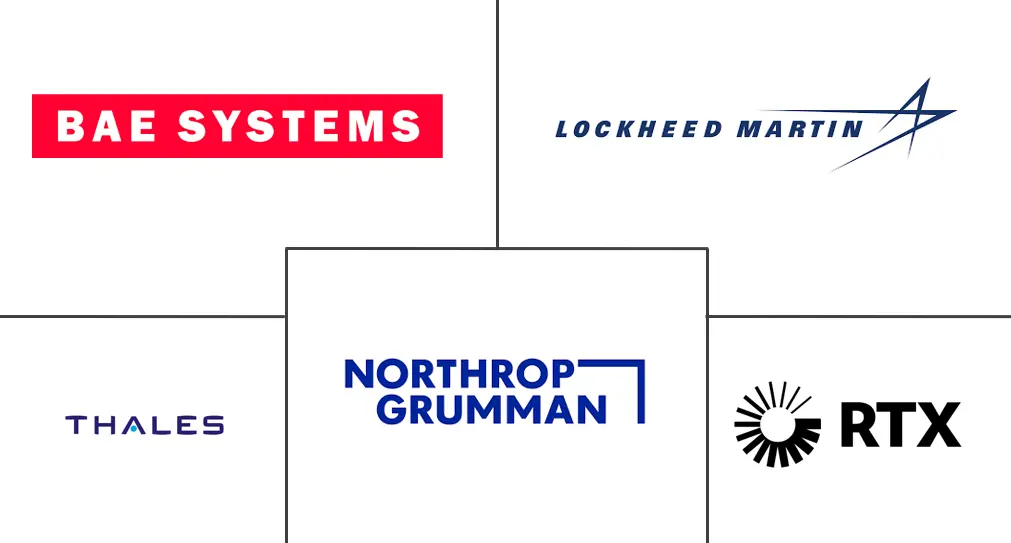Market Size of Military Aircraft Avionics Industry

| Study Period | 2019 - 2029 |
| Market Size (2024) | USD 37.14 Billion |
| Market Size (2029) | USD 45.05 Billion |
| CAGR (2024 - 2029) | 3.94 % |
| Fastest Growing Market | Asia Pacific |
| Largest Market | North America |
| Market Concentration | Medium |
Major Players
*Disclaimer: Major Players sorted in no particular order |
Military Aircraft Avionics Market Analysis
The Military Aircraft Avionics Market size is estimated at USD 37.14 billion in 2024, and is expected to reach USD 45.05 billion by 2029, growing at a CAGR of 3.94% during the forecast period (2024-2029).
Due to geopolitical tensions and border disputes, several countries worldwide are expediting their procurement of new military aircraft, helicopters, and drones, leading to a significant rise in military spending. Numerous nations are investing in modernizing their fleets with state-of-the-art equipment to bolster their aerial capabilities. These investments in the procurement and modernization of military aircraft are anticipated to drive market growth in the future.
The introduction of advanced avionics generates the need to replace old avionics systems in conventional military aircraft. These new avionics suites support the aircraft in meeting the new battlefield requirements, such as electronic warfare defense and long-distance target detection and tracking. Therefore, to stay abreast of adversaries, the defense forces plan to modernize the avionics in military aircraft. Various countries are procuring next-generation military aircraft to expand their fleets.
Various nations' rising demand for UAVs is driven by the increasing necessity to deploy them over hostile airspace, aiming to prevent any potential damage or danger to expensive manned aircraft. Besides their effectiveness in intelligence, surveillance, and reconnaissance (ISR) missions, UAVs can carry out combat target acquisition and search and rescue operations. The rising demand for UAVs is primarily motivated by the safety of crew members involved in non-combat missions. Additionally, the lower procurement cost of UAVs compared to traditional aircraft used for similar purposes has led to their increased acquisition by developing countries. However, challenges in certifications and integration of new hardware in advanced avionics systems hamper market growth. The changing nature of modern warfare, characterized by asymmetric threats and complex operational environments, necessitates the need for highly adaptable and flexible platforms. Such developments may create market opportunities in the future.
Military Aircraft Avionics Industry Segmentation
Avionics systems in an aircraft include communications, display, and management of multiple systems, navigation, and other systems fitted to the aircraft to perform individual functions. Military avionics systems include multiple electronic systems fitted onboard military aircraft to perform various functions.
The military aircraft avionics market is segmented into subsystems, aircraft types, and geography. By subsystem, the market is divided into flight control systems, navigation systems, communication systems, monitoring systems, and other subsystems. The other subsystems segment includes health terrain awareness and warning systems, monitoring/management systems, and weather systems. By aircraft type, the market is segmented into fixed-wing combat aircraft, fixed-wing non-combat aircraft, helicopters, and unmanned aerial vehicles (UAVs). Also, the report covers the sizes and forecasts for the military aircraft avionics market in major countries across different regions. For each segment, the market size is provided in terms of value (USD).
| Subsystem | |
| Flight Control System | |
| Communication System | |
| Navigation System | |
| Monitoring System | |
| Other Subsystems |
| Aircraft Type | |
| Fixed-wing Combat Aircraft | |
| Fixed-wing Non-Combat Aircraft | |
| Helicopters | |
| Unmanned Aerial Vehicles (UAVs) |
| Geography | |||||||
| |||||||
| |||||||
| |||||||
| |||||||
|
Military Aircraft Avionics Market Size Summary
The military aircraft avionics market is poised for significant growth over the forecast period, driven by increasing geopolitical tensions and the subsequent rise in military spending across various nations. Countries are rapidly procuring and modernizing their military aircraft, helicopters, and drones to enhance their aerial capabilities. This surge in demand is further fueled by the need to replace outdated avionics systems with advanced suites that meet contemporary battlefield requirements, such as electronic warfare defense and long-distance target detection. The growing necessity for unmanned aerial vehicles (UAVs) is also a key factor, as they offer cost-effective solutions for intelligence, surveillance, reconnaissance, and combat operations, while ensuring the safety of crew members in non-combat missions. Despite challenges in certification and integration of new hardware, the evolving nature of modern warfare presents opportunities for market expansion.
North America is expected to dominate the military aircraft avionics market, with the United States leading due to its substantial investments in defense capabilities amid rising global conflicts and geopolitical tensions. The U.S. Department of Defense is actively modernizing and expanding its regional defense forces, with significant contracts awarded for upgrading and acquiring advanced military aircraft and avionics systems. The market is semi-consolidated, with key players like RTX Corporation, Lockheed Martin Corporation, Thales, BAE Systems PLC, and Northrop Grumman Corporation holding significant shares. These companies are engaged in long-term contracts with aircraft OEMs and are investing in research and development to introduce advanced products. Such strategic initiatives are expected to drive market growth, as countries continue to enhance their aerial capabilities through technological advancements in avionics systems.
Military Aircraft Avionics Market Size - Table of Contents
-
1. MARKET DYNAMICS
-
1.1 Market Overview
-
1.2 Market Drivers
-
1.3 Market Restraints
-
1.4 Porter's Five Forces Analysis
-
1.4.1 Threat of New Entrants
-
1.4.2 Bargaining Power of Buyers/Consumers
-
1.4.3 Bargaining Power of Suppliers
-
1.4.4 Threat of Substitute Products and Services
-
1.4.5 Intensity of Competitive Rivalry
-
-
-
2. MARKET SEGMENTATION
-
2.1 Subsystem
-
2.1.1 Flight Control System
-
2.1.2 Communication System
-
2.1.3 Navigation System
-
2.1.4 Monitoring System
-
2.1.5 Other Subsystems
-
-
2.2 Aircraft Type
-
2.2.1 Fixed-wing Combat Aircraft
-
2.2.2 Fixed-wing Non-Combat Aircraft
-
2.2.3 Helicopters
-
2.2.4 Unmanned Aerial Vehicles (UAVs)
-
-
2.3 Geography
-
2.3.1 North America
-
2.3.1.1 United States
-
2.3.1.2 Canada
-
-
2.3.2 Europe
-
2.3.2.1 Germany
-
2.3.2.2 United Kingdom
-
2.3.2.3 France
-
2.3.2.4 Russia
-
2.3.2.5 Rest of Europe
-
-
2.3.3 Asia-Pacific
-
2.3.3.1 China
-
2.3.3.2 India
-
2.3.3.3 Japan
-
2.3.3.4 South Korea
-
2.3.3.5 Rest of Asia-Pacific
-
-
2.3.4 Latin America
-
2.3.4.1 Brazil
-
2.3.4.2 Mexico
-
2.3.4.3 Rest of Latin America
-
-
2.3.5 Middle East and Africa
-
2.3.5.1 Saudi Arabia
-
2.3.5.2 United Arab Emirates
-
2.3.5.3 Israel
-
2.3.5.4 Rest of Middle East and Africa
-
-
-
Military Aircraft Avionics Market Size FAQs
How big is the Military Aircraft Avionics Market?
The Military Aircraft Avionics Market size is expected to reach USD 37.14 billion in 2024 and grow at a CAGR of 3.94% to reach USD 45.05 billion by 2029.
What is the current Military Aircraft Avionics Market size?
In 2024, the Military Aircraft Avionics Market size is expected to reach USD 37.14 billion.

